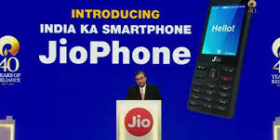Reliance Jio’s much-anticipated launch on Thursday offering free voice calls and data services at very low tariffs resembles a similar “disruptive” strategy that the company had adopted 13 years ago.
In 2003, Mukesh Ambani-controlled Reliance India Mobile stormed the market with a “Monsoon Hungama” scheme, which offered mobile connection and a handset at R501.
As incumbent operators jostled to keep their customer base intact, tariffs plunged, making mobile phones affordable for millions and breaking down class barriers.
From about R5 then, a call now costs as low as 45 paise per minute despite intervening years of inflation and growth that makes the rupee go less far.
With voice calls no longer expected to remain the dominant money spinner, a similar tariff war looks imminent on data services as browsing battles move to palmtops.
Reliance Jio has placed its bets firmly on low tariffs to push data volumes, which is evident from the strategy of making calls free. The move will force incumbents to lower rates.
“We foresee operators gradually moving towards simpler all-you-can-eat plans wherein subscribers would be offered unlimited voice and fixed data access for a lumpsum amount, rather than the forest of foggy options available today,”said Ajay Srinivasan, director at Crisil Research. “Tariffs will tumble, and we project average data realisations halving to less than R0.10 per MB by 2017-18, compared to less than R0.20 per MB currently.”
In 2003 when Reliance entered the market, it was dominated by a few incumbent players, including Airtel, which commanded a significant market share in the voice telephony business.
The conditions are different this time round.
The data sector is still very much in its infancy and remains a fledgling line of business for operators.
This will make it easier for incumbents to adjust their data tariffs to match Reliance Jio’s offer.
“The Indian telecom sector is at an inflection point of massive data adoption, repeating the precedence of the voice market growth trajectory (2007-2011),” said Tanu Sharma, associate director at India Ratings. “This will necessitate continued investment in the key resource—spectrum—during the coverage expansion phase.
“Competition has to gear up. Operators have to make increased investment both in terms of coverage and quality,” Rajan Mathews, director-general, Cellular Operators Association of India (COAI), told HT.






Leave a reply